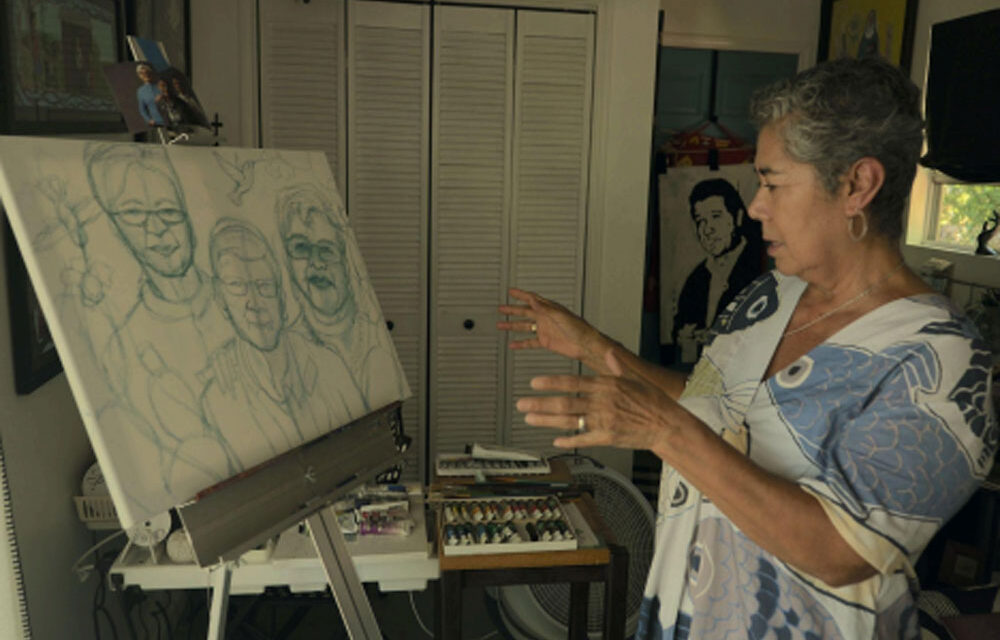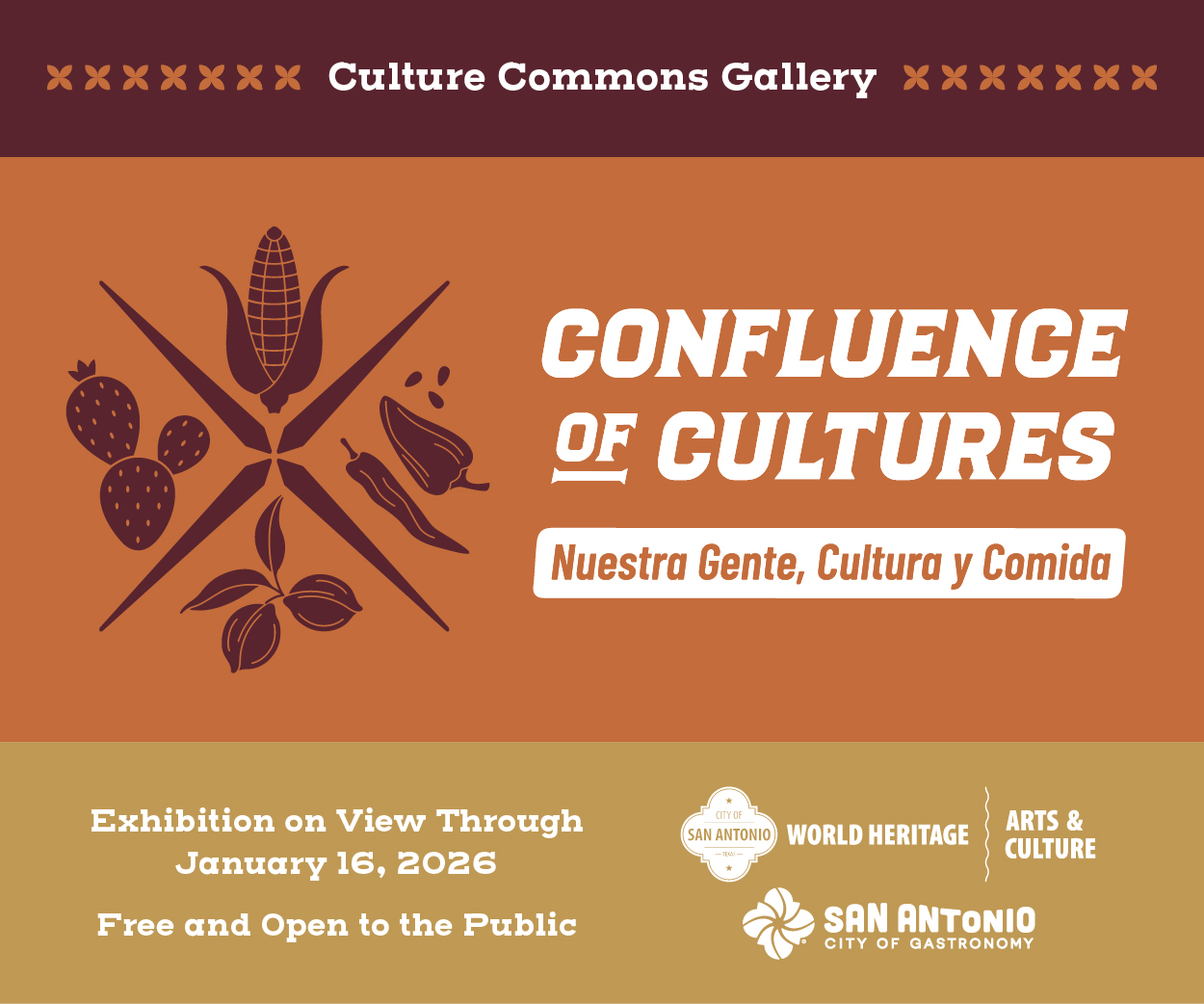Terry Ybañez knew at age five, as she drew and painted flowers and plants she saw in her grandmother’s garden, that she wanted to be an artist. She grew up in the deep San Antonio Westside and took middle and high school art classes. She discovered in high school that her best learning experiences resulted when students gathered regularly to discuss their art projects and share ideas. While in high school, Ybañez found part-time work with the Southwest School of Art teaching young children to draw and paint. In her senior year at Wheatly [Brackenridge High School], her artistic interests shifted toward fashion design.
Ybañez’s interest in fashion and a scholarship led her to Stephens College in Columbus, Missouri. She stayed only a year and a half, long enough to discover that sewing garments was not as creative as designing and drawing, and lost interest in becoming a fashion designer. She returned to San Antonio and completed a degree in Fine Arts at Trinity University in 1982.
Ybañez lived in Austin over the next year bonding with artists active in La Peña, a Latina art collective. She returned to San Antonio in 1984 to work on a teaching credential at UTSA where she also earned a Master’s degree in 1987. Over the next ten years, she pursued several creative and teaching opportunities in San Antonio, Austin, and Oakland, California, and signed on for an 18-month stint in Kuwait designing art and science educational activities for a children’s museum.
Artists like Ybañez who enjoy working in a variety of artistic fields are always ready to experiment as a muralist, painter, printmaker, educator, or book
illustrator. These artists generally recall that first moment when a great opportunity to try something new and exciting came along. Such was the case when Sandra Cisneros asked Ybañez to illustrate her new children’s book Hairs/Pelitos published by Random House.
Ybañez was teaching art to young children at the Guadalupe Cultural Center in the mid-1980s when she met Cisneros. Cisneros, the Literature Director at the Westside Center, took an interest in Ybañez’s artwork and followed her career. Cisneros’s career took off when she published her book The House on Mango Street with Arte Publico Press. The book made The New York Times bestseller list and over the next 30 years sold six million copies. The book was also translated into 20 languages.
Ybañez told me that when Cisneros approached her in 1984 about illustrating the children’s book, Hairs/Pelitos, the celebrated author allowed her full “creative freedom.” Ybañez chose to paint children featured in the book with different skin colors so that any child could relate to the story.
Working at the Guadalupe Cultural Center in the 1980s, Ybañez also met the poet Carmen Tafolla and publisher Bryce Milligan. Milligan asked Ybañez to illustrate Tafolla’s children’s book about Texas labor
leader Emma Tenayuca. Ybañez had painted a mural featuring Tenayuca, one of her sheroes–strong women she admires. Ybañez said yes to the book illustration offer. She believes in seizing the moment, telling me “When a door opens, never be afraid to walk through it.”
Tenayuca was a legend in San Antonio’s Westside. Ybañez loved the book illustration project that featured Tenayuca’s efforts to unionize women pecan shellers during the Great Depression when the U.S. Government repatriated Mexican-born workers to their homeland. Tenayuca founded the Workers’ Alliance Union in 1938 which called for the
Pecan-Shellers’ Strike. More than 10,000 strikers joined the labor protest, one of the largest labor walkouts in the country.
In cities across the Southwest, museums’ doors were largely closed to Latina/o artists in the early 1980s when Ybañez was getting her start as an artist. During the first half of that era, with a few exceptions, Chicano and Latino artists seldom received exhibit
invitations from Texas museums or commercial galleries. Ybañez recalls that Latino organizations, in particular, the Guadalupe Cultural Arts Center, Centro Cultural Aztlan, and La Peña in Austin, opened doors for her and many other Latinos.
In 1986, a Blue Star Contemporary art exhibit curated by Lucy Lippard included works by Ybañez. While living in Austin in the early 1990s, Ybañez painted Mi Madre, an oil painting portraying her mother as a martyr suffering from seven arrows that penetrated her body. The seven arrows represented the seven males in her family. In 1992, Southwest School of Arts opened a wide door for her by giving her a one-person show.
In her oil canvas artwork, “Cutting Tongues” [1996], Ybañez addresses the struggles of children and young teens attempting to preserve their language and culture. She lamented, “Why do we lose our mother tongue, the language we are born into? My mother tongue is Spanish.” She explained that she lost some language skills in the 1960s when teachers prohibited students from speaking Spanish at school. Her teachers also told her bilingual parents to speak only English to their children at home. She added, “This always confused me since my abuelos
[grandparents] spoke to us in Spanish. I loved listening to their stories in Spanish, their instructions in Spanish, and even their scoldings in Spanish.”
Over the past twenty-five years, Ybañez’s life has been filled with painting, teaching, and community service. For seventeen years from 2004 to 2021, she taught art at Brackenridge High School. Ybañez attended there as a high school student, organized art events, and shared ideas and art skills with her high school friends. As a preschool, middle school, and high school teacher, she influenced many talented Latina and Latino artists. She was pleased that one of her students, Andrea Rivas, has recently collaborated with other artists to paint a major mural in the Southside honoring 54 immigrants who lost their lives in San Antonio tragically suffocating in a truck that had transported them across the Texas-Mexico border.
Ybañez is retired from teaching but is actively
engaged in painting and preserving the cultural
heritage of her San Jose Mission neighborhood. The mission and surrounding area are part of the San Antonio UNESCO World Heritage site. Ybañez has worked with other community activists to support parks and the preservation of historic spaces near the mission where she lives and has her art studio. She eagerly awaits the next door to open that will enable her to expand her work as an artist.
Terry Ybañez: Latina Artist and Community Activist






